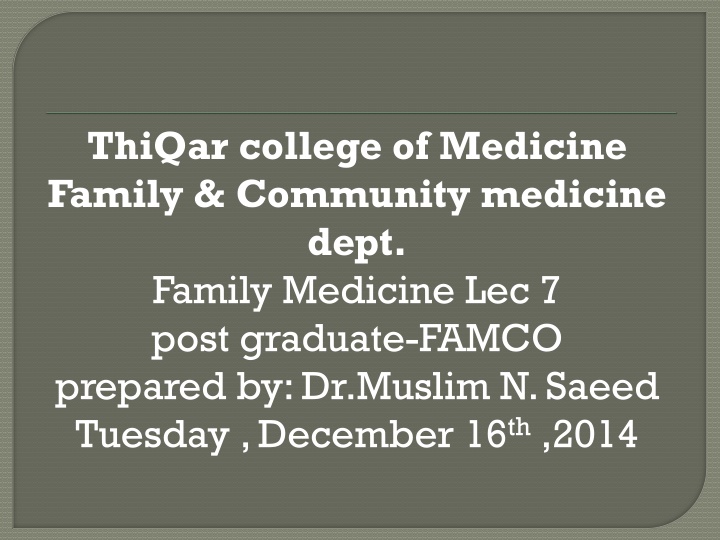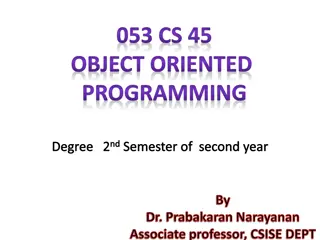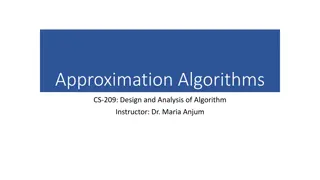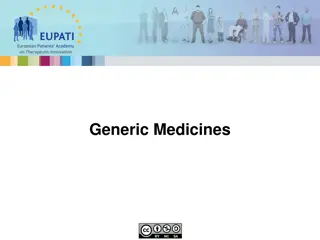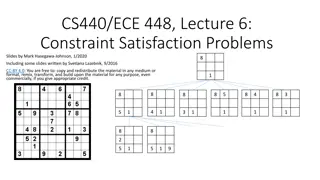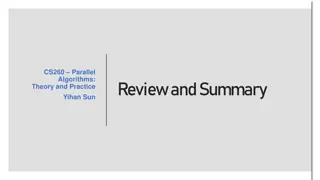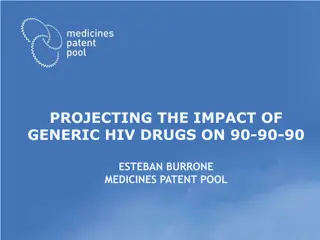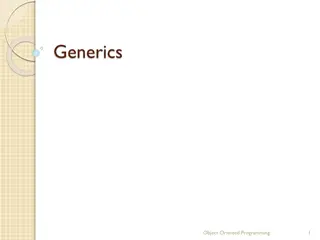Generic Algorithms in C++: Evolution from Basic to Advanced Concepts
This content delves into the evolution of generic algorithms in C++, starting from basic linear search methods to advanced implementations using ranges and generic iterators. The progression showcases how the algorithms have been refined and abstracted, maintaining their fundamental structure while achieving greater flexibility and generality. Through examples and explanations, the text explores the adaptation of algorithms to different types and containers, emphasizing the importance of parameterization and abstraction for creating versatile and efficient algorithms in C++.
Download Presentation

Please find below an Image/Link to download the presentation.
The content on the website is provided AS IS for your information and personal use only. It may not be sold, licensed, or shared on other websites without obtaining consent from the author.If you encounter any issues during the download, it is possible that the publisher has removed the file from their server.
You are allowed to download the files provided on this website for personal or commercial use, subject to the condition that they are used lawfully. All files are the property of their respective owners.
The content on the website is provided AS IS for your information and personal use only. It may not be sold, licensed, or shared on other websites without obtaining consent from the author.
E N D
Presentation Transcript
ThiQar college of Medicine Family & Community medicine dept. Family Medicine Lec 7 post graduate-FAMCO prepared by: Dr.Muslim N. Saeed Tuesday , December 16th,2014
ADHD Dental caries Domestic violence Falls in elderly Influenza NTD SIDS Anemia Syphilis HIV Asymptomatic Bacteriuria Celiac disease
-Children aged 612 years with inattention, hyperactivity, impulsivity, academic under- achievement, or behavioral problems. -Diagnosis requires the child meet DSM-IV criteria and direct supporting evidence from parents or caregivers and classroom teacher. Evaluation of a child with ADHD should include assessment for coexisting disorders.
I: Either A or B. A: Six or more of the following symptoms of inattention have been present for at least 6 months to a point that is disruptive and inappropriate for developmental level. Inattention: 1) Often does not give close attention to details or makes careless mistakes in schoolwork, work, or other activities. 2) Often has trouble keeping attention on tasks or play activities. 3) Often does not seem to listen when spoken to directly. 4) Often does not follow instructions and fails to finish schoolwork, chores, or duties in the workplace (not due to oppositional behavior or failure to understand instructions). 5) Often has trouble organizing activities.
6) Often avoids, dislikes, or does not want to do things that take a lot of mental effort for a long period of time (such as schoolwork or homework). 7) Often loses things needed for tasks and activities (eg, toys, school assignments, pencils, books, or tools). 8) Is often easily distracted. 9) Is often forgetful in daily activities.
B: Six or more of the following symptoms of hyperactivity- impulsivity have been present for at least 6 months to an extent that is disruptive and inappropriate for developmental level. Hyperactivity: (1) Often fidgets with hands or feet or squirms in seat. (2) Often gets up from seat when remaining in seat is expected. (3) Often runs about or climbs when and where it is not appropriate (adolescents or adults may feel very restless). (4) Often has trouble playing or enjoying leisure activities quietly. (5) Is often on the go or often acts as if driven by a motor. (6) Often talks excessively.
Impulsivity: (1) Often blurts out answers before questions have been finished. (2) Often has trouble waiting one s turn. (3) Often interrupts or intrudes on others (eg, butts into conversations or games). II: Some symptoms that cause impairment were present before age 7 years. III: Some impairment from the symptoms is present in two or more settings (eg, at school/work and at home). IV: There must be clear evidence of significant impairment in social, school, or work functioning. V: The symptoms are not better accounted for by another mental disorder (eg, mood disorder, anxiety disorder, dissociative disorder, or a personality disorder).
Children and adolescents: Recommends fluoride supplementation to prevent dental caries for infants and children aged 6 months through 16 years residing in areas with inadequate fluoride in the water supply (< 0.6 ppm). # controversy
Adolescents, adults and adult women: Recommend programs that emphasize preventing violence. -Interventions of possible efficacy include: a. School-based programs that teach children to recognize and avoid abusive situations. b. Empowerment and relationship skills training for women. c. Programs that change social and cultural gender norms.
1. 30%40% of all community-dwelling persons aged 65 years fall at least once a year. 2. Falls are the leading cause of fatal and nonfatal injuries among persons aged 65 years. 3. A review and modification of chronic medications, Including psychotropic medications, is important although not proven to reduce falls.
Recommendations: 1. Ask older persons(screen) at least yearly about falls. 2. Recommends vitamin D supplementation (800 international units [IUs] orally daily). 3. Recommends home-hazard modification (adding nonslip tape to steps, provision of grab bars, etc.) for all homes of persons aged 65 years. 4. Recommends exercise or physical therapy interventions targeting gait and balance training.
1. Influenza vaccination is the best way to prevent influenza. 2. Antiviral chemoprophylaxis is not a substitute for influenza vaccination. 3. Duration of chemoprophylaxis is 2 weeks post- vaccination in most persons but is indicated for 6 weeks in children who were not previously vaccinated or who require two vaccine doses. 4. Chemoprophylaxis for 10 days in a household in which a family member has influenza. 5. Agents for chemoprophylaxis of influenza A (H1N1) and B: zanamivir or oseltamivir.
-Consider antiviral chemoprophylaxis for adults and children aged 1 year at high risk of influenza complications when any of the following conditions are present: a. Influenza vaccination is contra-indicated. b. Unvaccinated adults or children when influenza activity has been detected in the community. Vaccinate simultaneously. c. Unvaccinated adults and children in close contact with people diagnosed with influenza. d. Residents of extended-care facilities with an influenza outbreak.
-Highest-risk groups for influenza complications are: a. Pregnant women b. Children aged 6 months 4 years d. Adults aged 50 years e. Persons with chronic medical conditions. f. Residents of extended care facilities. h. Morbidly obese (BMI 40) persons. i. Healthcare personnel. j. Household contacts or caregivers of children aged < 5 years or adults aged 50 years.
All persons aged 6 months receive Annual trivalent seasonal influenza immunization.
Recommendation : 1) Women planning or capable of pregnancy take a daily supplement containing 400 800 mcg of folic acid. 2) Women planning a pregnancy should start folic acid supplementation at least 1 month before conception and continue through the first 2 3 months of pregnancy. 3) Recommend 4 mg/day folic acid for women with a history of a child affected by a neural tube defect.
-Stomach and side sleeping have been identified as major risk factors for SIDS. -Recommendations: Counsel all parents to place their infants on their backs to sleep.
-Infants aged 612 months: Risk assessment based on diet, socio- economic status, prematurity, and low- birth-weight should be done. - High risk infants Includes infants living in poverty, from developing countries, preterm and low-birth-weight infants, and infants on unfortified cow s milk or soy milk.
-Pregnant women: Screen all women with hemoglobin or hematocrit at first prenatal visit.
-Strongly recommends routine screening of all pregnant women at the first prenatal visit. -A non-treponemal test (Venereal Disease Research Laboratory [VDRL] or rapid plasma reagent [RPR] test) should be used for initial screening. -Recommends screening high-risk persons.
High-risk includes: 1) commercial sex workers 2) persons with other STDs (including HIV) 3) sexually active homosexual men 4) sexual contacts of persons with syphilis gonorrhea, chlamydia, or HIV infection.
A- Pregnant women: 1) Include HIV testing in panel of routine prenatal screening tests. 2) Retest high-risk women at 36 weeks gestation. 3) Rapid HIV testing of women in labor who have not received prenatal HIV testing.
B. HIV screening should be offered to all people who seek evaluation for STDs and all adolescents who are sexually active or who engage in injection drug use. -HIV testing should be voluntary and must have a verbal consent to test. -Educate and counsel all high-risk patients regarding HIV testing, transmission, risk-reduction behaviors, and implications of infection.
1. Homosexual men 2. multiple sexual partners 3. history of intravenous drug use 4. Prostitution 5. history of sex with an HIV-infected person history of STDs 6. persons requesting an HIV test.
-Recommend screening for bacteriuria at first prenatal visit or at 12 16 weeks gestation. # no recommendation for screening in men and non pregnant women.
-IgA tissue trans-glutaminase (TTG) is the test of choice. -Recommend serologic testing in children and adults to screen for Celiac disease in the following: Chronic diarrhea, failure to thrive, persistent, recurrent or unexplained GI symptoms, prolonged fatigue, unexpected weight loss, unexplained anemia, autoimmune thyroid disease, IBS,type 1 diabetes, or first-degree relatives with celiac disease.
